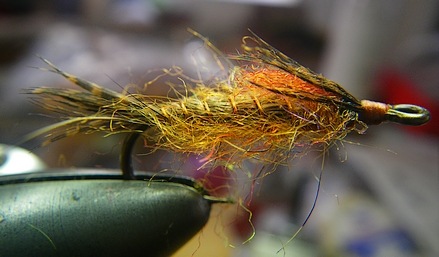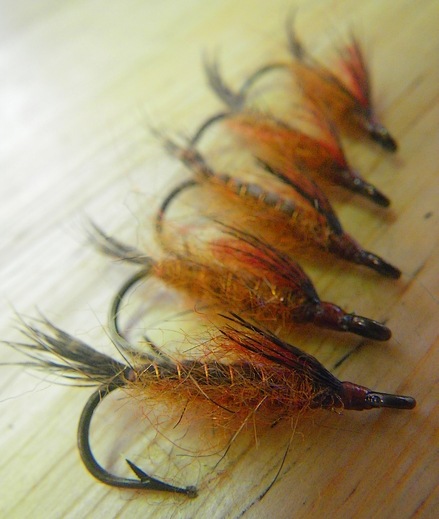I’ve oft wondered at all the toil and expense for the rod maker to remove a sixteenth of an ounce and whether all that engineering and measurement made enough difference to matter. Likewise for that disc drag and aircraft grade titanium that the reel maker boasts is so much more sturdy and durable, and whether he too wasn’t simply enamored with differences versus any tangible effect.
The line maker insists that slick or pebbled is the one true finish, and countless scientists struggle to define slick, in hopes of making it more so.
Heavy butted, limp, monofilament or fluorocarbon to transfer the line’s energy to the fly, but there the refinement and science dies, as fly choice is a mixture of semi-educated premise, intuition, and guesswork.
Figure the average outfit has been tuned by forty or fifty scientists, each with their own ideas on action, stiffness, and weight. Many thousands spent on rare earths and minerals to coat and build the ensemble, and when it finally gets to you, you can’t decide whether to use one or two split shot to drag sharp stuff through deep stuff?
I find it just a bit humorous, and why I can’t stifle a giggle when some rod engineer uses terms like “pure” and “essence”.”
As a fly tier I find fault with overtly heavy rigs or flies. Early Spring fishing is largely dominated by weighted, beaded, thick and heavy, all of which yanks at me when I yank at it, and makes fishing a series of flop casts that carry the weight due to energy imparted by my arm, versus imparted by a fly line – or something that bent the blank.
Like all those engineers are likely to tell you, there’s more than a single way to do anything – including sinking a fly.
Profile can act like more weight if it’s catered to in the fly’s design. Wide and fat increases resistance to motion in any direction, especially fast sinking and lifting the rig back to the surface. Extra shot can drive anything to the bottom quickly, but is never much fun to lob for any length of time -considering the wear and tear on knots and especially lighter tippets.
Recognizing this from past seasons and planning to switch to a lighter line size this year, allows me to preplan some of the flies needed, given that I have the luxury of tying flies that will be lighter, yet sink as quickly as needed due to their slim profile.
Just as important, a slim profile allows me to get them out of the water with alacrity, something quite desirable in a hook set, and may allow the rod to roll cast the rig to the surface to position for the next cast.
Spring being host to all those big dark artificials, stoneflies mostly; many of us will be cracking out big pillow shaped chenille monstrosities, replete with rubber legs and tungsten beads. That’s less of a bother with #5’s and #6’s, but using a #3 or #4 line they’ll be effective only in lobbing flies given both their weight and water resistance.
I decided to “channel” some of the old Polly Rosborough Golden stone designs to different colors as his design is a lighter weight than traditional fare, and allows me some additional flexibility while I prepare for a high water Spring – and a light line mainstay.

The shank is covered in lead from tail to whip finish, with only a bit of combed fur to impede sinking. It’ll fish where the fish should be without extra beads and split shot, and ensures an enjoyable heave compared to the weighted hamburger the other fellow is throwing.

Thin silhouette is matched by other functional attributes consistent with a heavy nymph. Reinforcing wire on all the feather delicates, three coats of cement on the head, and a blood red tuft of fur making the underwing, adding a hint of attractor to the finished pattern.
Heavy wire is consistent with banging about the rocks, as is the thick spear point – on a fly destined to hook many things, some of which may be desirable.
Few anglers optimize their flies knowing what’ll be throwing it. Favorite patterns also restrict us a bit, given our reluctance to try anything new. On a big meal like a stonefly I’d suggest fish won’t be as selective, allowing us to add that additional dimension, something tailored for the characteristics of the rod.
That’s a lot of scientists insisting a few grams are worth many hundreds of dollars. No reason not to pay attention to the ease of your rig when fished, and the shape and style of its terminal tackle.

….a blood red tuft of fur making the underwing, adding a hint of attractor to the finished pattern.
That is brilliant, have never considered adding something like that to my nymphs.
I love this post!
I’d rather put my faith in the terminal tackle and fly than in the giga-buck, no-weightium rod. One to three nymphs and/or an indicator fly plus any 9 or 10 foot rod that one can chuck and duck, and you’re in business.
We don’t need no stinkin’ science, just the school of hard rocks!
Those hooks rock!
The reason these new high tech rods cost so much is because those teams of “scientists” and “engineers” (no doubt contracted from leading universities world wide) don’t work cheap. On the other hand, how can we know they exist at all – except in some adman’s overheated hype ? Remember the famous old “Louisville slugger,” now replaced by anodized aluminum/titanium/teflon/fibreglas wizardry ? God knows what it costs to equip a Little League team nowdays – and that’s not counting the steroids ! A new century, gents ! “Progress.” you’re looking at it. Try to be good sports about it.
Are you trying to tell me fish will strike flies that are NOT made with UltraUVkrystalopallateralscaleicewingnanoflash, rubber legs, and 3 coats of epoxy on the back?
@Mark – If fifty years of drab mayfly imitations can’t put the Royal Coachman to bed, then “Matching the Hatch” is a pile of spilt chocolate that looks like Jesus …
While they’ll show up on the Internet and someone is liable to leave a candle or two,I don’t think they’re divine.
@John Best quote I’ve seen yet, “school of hard rocks.”
@Fat Bluegill: Mustad 4450: http://singlebarbed.com/2010/05/27/ancient-iron-revisited/
Yomomma: I thought snickers and a coke was Performance enhancing enough – they use steroids too?
Rex:I always wanted to tie a fly with epoxy, but mine was the generation past “huffing” and the hardware store wouldn’t sell me any
yomama has a good point…crack somebody in the kneecap with the tinman’s bat…they still go down but the “ping” is so girlish…totally unsatisfying.
new and ubertech drive the business but it isn’t inherently better.
Depth charge flies look good. But once you de-Ahab those irons will these nymphs still plow through the water right-side up?
Sink testing may be in order. Alternatively you could have Cal Poly develop a computer model to answer the question.